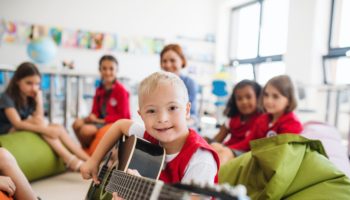Pam Schaffner
Inclusion is a relatively new concept in the course of human history. Before the 19th century, those with disabilities were often considered cursed or even possessed and were largely removed from society. They were often institutionalized in hospitals or even jails.
In recent decades how persons with disabilities are educated and treated in society has made great strides. The evolution of inclusionary practices has been gradual, however, a great landmark within that evolution happened in 1975. In that year, the Education for All Handicapped Children Act was passed by Congress. Recognition was being made that children’s needs were not being met as many children were excluded from public education. That Act was reauthorized in 1990 and renamed Individuals with Disabilities Education Act (IDEA). In an article titled “A History of Inclusive Education” the author writes:
“…most states used institutions which kept children with disabilities out of mainstream society. The popular assumption seemed to be such students were unable to learn, had little to no capabilities, and, in a society in which worth is often based on production, had little value to add. Society began to shift, however, in 1975 with the Education for All Handicapped Children Act. The Act acknowledged the need for students with exceptionalities to receive a quality education in “the least restrictive environment” possible. This meant the students were being seen by the government as full citizens of the United States, which quickly turned into a higher quality of life for children with exceptionalities and their families.”
So how do we know we are providing the best inclusion opportunities in our early childhood classrooms? It is important to realize that inclusion is much more than having a handicapped accessible building or being welcoming to children with special needs being enrolled in the classroom. Young children with special needs do need treated fairly and not excluded from a program from an equity standpoint, but inclusion is much, much more. It is not just about being accepting; it is about providing adaptations for their success in your program.
Accessibility to the classroom is needed to provide that adaptation for enrollment, however, accessibility in the classroom considers things such as wide-open passageways between learning centers and keeping the classroom floor clean and uncluttered so children can move around safely. The storage of learning materials is also important; can everyone reach them?
Once a classroom set up encourages accessibility, individualized adaptations need to be considered: adaptions might be needed in materials, lesson plans, or interactions with children. When considering adaptations, it is important to consider IDEA. Above the term “least restrictive environment” was mentioned. This means that we use as few strategies or adaptations that are needed for the child to succeed. For example, if a child has a developmental delay that makes using scissors difficult, it would not be appropriate to merely cut things out for the child. Instead, we would buy specialized scissors (spring opening scissors, for example) to assist the child in completing the task. Tongue depressors can be taped to pages of books for them to be more easily turned. Thicker crayons can be used (knobbed crayons) and paper can be taped to the tabletop for a child to participate in art. Knobbed puzzles or puzzles more easily with fewer pieces may be added to a classroom so all children can do a puzzle. Choosing toys based on a child’s physical and cognitive abilities and adding them to the environment makes that classroom more inclusive. It also provides more variety in toys for the whole group. For whole group activities, a child may need fidget toys or a special chair to sit in so they can fully participate. A timer might be an adaptation that can be used to entice a child to participate for a certain length of time or to help them wait for a turn.
Lesson plans should be modified so all children in the classroom will experience a level of success. It is advised to add to the general “whole class” lesson plan a section that can be used to write down the modifications that will be needed. Be sure to write modifications that are needed for individual children. For example, write child A will be helped to meet lesson plan objectives by this strategy, and write that strategy down. Use the child’s IEP or IFSP goals to inform your modifications. Often a child with a special need has therapists or special support personnel come to work with individual children in the classroom. It is vital, however, to ensure that children are still working on those IEP and IFSP goals when that person is not present. The therapist should be communicating with the teacher ways to adapt class lesson plans to ensure children with special needs not only participate but participate while practicing the skills they need.
Often, we need to adjust our interactions with children who have special needs. Whether their goals include behavioral goals, language goals, or cognitive goals, how we interact with them makes a difference. Teachers can become frustrated when a child with special needs does not or cannot do what their peers do. Extra patience is needed when children have developmental delays.
Displaying rules, using books about how to solve social challenges, staying close and coaching a child through a difficult situation with a peer are all needed. Sometimes cue cards (visuals) can help a child who may not verbalize wants and emotions. For example, a teacher may make cards to show options for an argument over a toy. The teacher can present the child a picture of wait a turn (clock picture), share the toy (two children with one toy). Picture cards can be used for a non-verbal child to be able to ask to use the restroom, have something to eat, or even pictures of how to say yes and no. When a child has a more profound verbal delay, they may use a computer or assistive technology device to communicate.
Inclusion happens best when we fully understand the child. Getting to know them involves talking to them and their parents. Building a close relationship with a child will help us meet their needs fully and know when they need extra support. Intervention requires adaptations to materials, interactions, and lesson plans so the children can remain with their peers in play and learning activities. Intervention is not removing a child to work on IEP or IFSP goals in a vacuum, but when these goals are worked on in the community of the classroom. In the book Choosing Outcomes and Accommodations for Children, Third Edition, by Michael F. Giangreco et al., inclusion is summed up like this: We will know that inclusive education has really become embedded in our culture when the term becomes obsolete.




